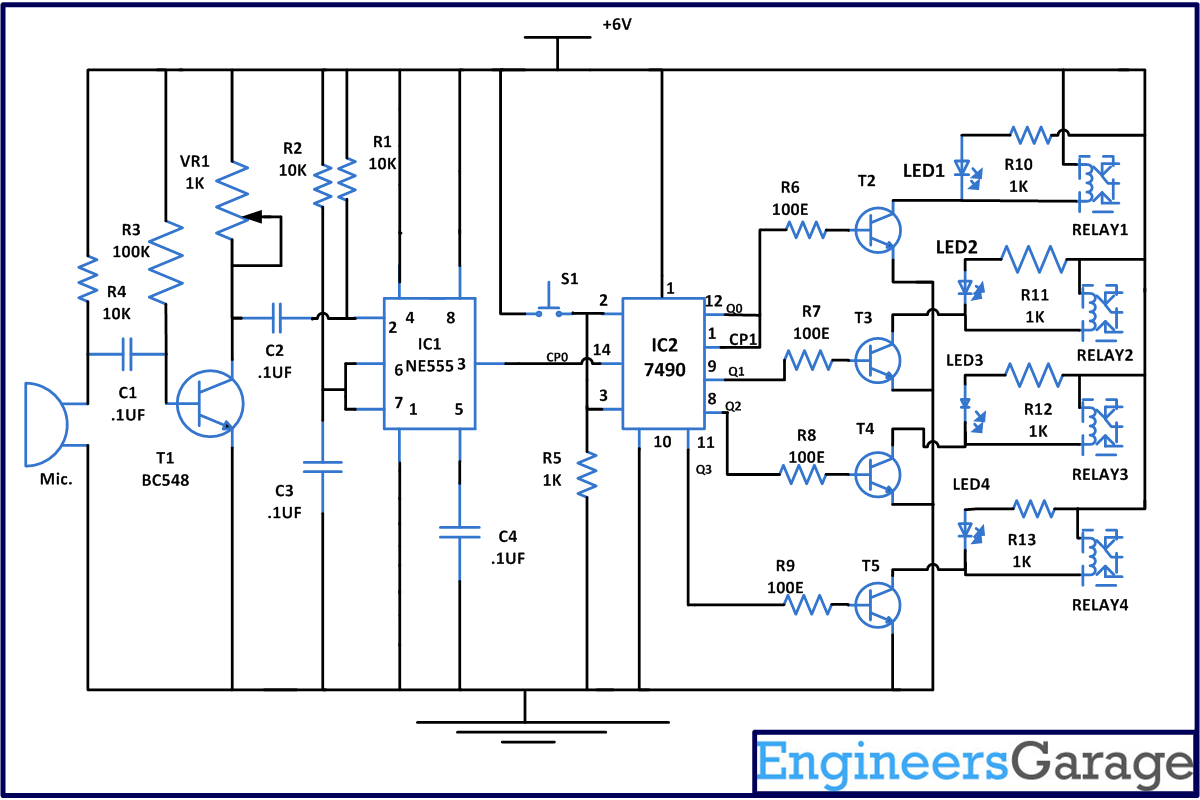With the help of this circuit you can control your home appliances without getting off from your bed. You have to just clap or puff in front of the microphone and the device connected to it become "on" or "off". Features of this clap switch circuit are as follows:-
1. You can simultaneously "on" and "off" one, two or three devices.
2. You are not required to move from your place to "on" or "off" the devices.
3. It will give you visual indication of the appliances also.
[[wysiwyg_imageupload:8354:]]
Fig. 1: Prototype Of Clap Switch Circuit On Breadboard
The clap switch circuit is build around two IC’s –
1. NE555 Timer IC which is configured in monostable mode.
2. 7490 IC which is a decade and binary counter. It contains four master slave flop and also contain divide by two and divide by five counter. It can be used as divide by 9 counter by connecting Q0 with clock input pin1 (CP1) and providing clock pulse to CP0 that is on pin14. It can also be used as divide by 6 counter by connecting Q0 with CP0 and giving input pulse at CP1.
7490 IC will provide you the 9 different combination to “on” and “off” the four different application in 9 claps. Similarly 7492 IC is also available which will provide you 11 different combination of output for controlling the four appliances. And another is 7493 which provide 15 different ways to control the four appliances.
When you clap in front of the Mic, clapping sound is converted into electrical energy by the microphone. These weak signals are then amplified by the transistor which acts as preamplifier. Sensitivity of the signals can be improved with the help of VR1. Now the transistor T1’s output is feed to monostable circuit which is wired NE555 IC. Whenever you clap in front of microphone, output pin 3 of IC1 goes high and this is fed to clock input of IC2 pin 14. The output of IC2 is now provided to transistor T2-T4 through 100 ohm resistor to derive the corresponding relay connected to it. We have also connected different colour LED to indicate the state of the different appliances. If LED glows means that device is “on”. If LED does not glows means device is “off”.
The output stage of IC7490 (Q0-Q3) for different numbers of clap are shown in table-
|
No. of Claps |
Q0 |
Q1 |
Q2 |
Q3 |
|
0 |
0 |
0 |
0 |
0 |
|
1 |
1 |
0 |
0 |
0 |
|
2 |
0 |
1 |
0 |
0 |
|
3 |
1 |
1 |
0 |
0 |
|
4 |
0 |
0 |
1 |
0 |
|
5 |
1 |
0 |
1 |
0 |
|
6 |
0 |
1 |
1 |
0 |
|
7 |
1 |
1 |
1 |
0 |
|
8 |
0 |
0 |
0 |
1 |
|
9 |
1 |
0 |
0 |
1 |
Here logic 1 indicates that corresponding transistor conducts to energise the corresponding relay and activate the device connected to it. And logic 0 describes that device is inactive.
Circuit Diagrams
Project Components
Project Video
Filed Under: 555 Timers, Electronic Projects
Filed Under: 555 Timers, Electronic Projects



Questions related to this article?
👉Ask and discuss on Electro-Tech-Online.com and EDAboard.com forums.
Tell Us What You Think!!
You must be logged in to post a comment.